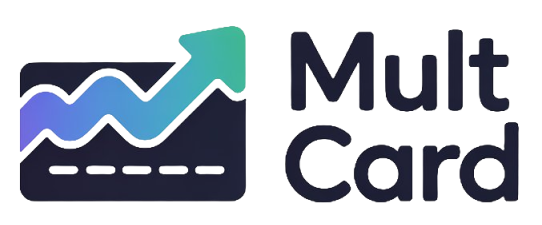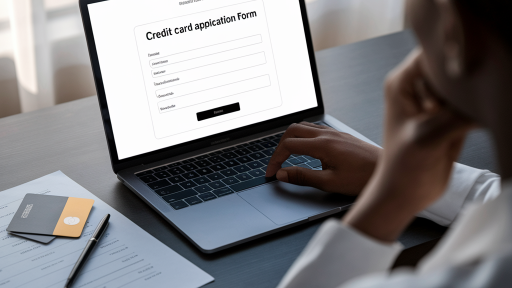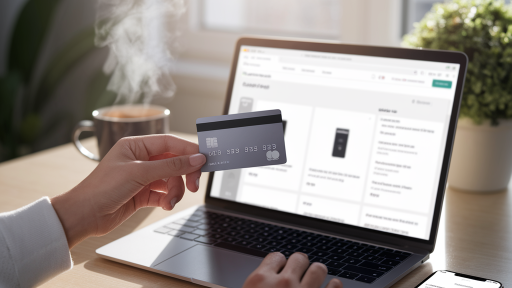In our increasingly digital world, the way we shop and manage our finances is constantly evolving. We’ve moved from cash to plastic cards, and now, we’re taking another leap into a more virtual realm. If you’ve ever felt a flicker of anxiety while entering your credit card details on a new website, you’re not alone. This concern has fueled the rise of a powerful financial tool: the online credit card.
But what exactly is it? Is it a replacement for the familiar plastic in your wallet, or something else entirely? This comprehensive guide will demystify the concept, explaining precisely what an online credit card is, how it functions, and why it might just be the key to more secure and controlled online spending for you.
Understanding the Basics: What Exactly is an Online Credit Card?
An online credit card, often used interchangeably with terms like “virtual credit card” or “digital card,” isn’t a physical piece of plastic. Instead, it’s a unique, randomly generated set of payment credentials—a 16-digit card number, a CVV security code, and an expiration date—that is linked to your primary credit or debit account. Its main purpose is to act as a secure intermediary for online transactions.
Think of it as a protective mask for your real financial information. When you use an online credit card, you’re providing the merchant with these temporary, disposable details instead of your actual, permanent card number. If these details are ever compromised in a data breach, your primary account remains completely untouched and secure, as the virtual number can be easily deleted or “frozen” without affecting your physical card.
Online vs. Physical Cards: The Core Distinction
The fundamental difference lies in their form and intended use. A physical credit card is a tangible object designed for both online and in-person (point-of-sale) transactions. An online credit card exists only in a digital format and is specifically created for e-commerce, subscriptions, and other card-not-present payments. While you can’t swipe a virtual card at a grocery store, you can often add it to a mobile wallet like Apple Pay or Google Pay for contactless in-person payments, blurring the lines between the two.
How Does an Online Credit Card Function? The Step-by-Step Process
The magic of an online credit card lies in its simplicity and the robust security layer it adds to your transactions. While the technology behind it is complex, using one is remarkably straightforward. The process generally follows four key steps.
1. Generation of Card Details
The first step is creating the card itself. This is typically done through your bank’s mobile app, online banking portal, or a third-party fintech service. With a few clicks, the system generates a brand new, unique card number, expiration date, and CVV. You often have control over the card’s parameters at this stage, such as setting a specific spending limit or making it a single-use card that deactivates after one purchase.
2. Linking to a Funding Source
The newly generated virtual card doesn’t have its own balance. Instead, it acts as a pass-through to your real funding source. This could be your main credit card account or, in some cases, your debit/checking account. When a purchase is made with the virtual card, the charge is authorized and then passed on to be billed to this primary account.
3. Making an Online Purchase
This part is just like any other online checkout process. When you’re ready to pay on a website, you simply copy the details of your online credit card (number, expiry, CVV) from your banking app or service and paste them into the payment fields. The merchant’s system sees it as a standard credit card transaction and has no idea that it’s a virtual, temporary number.
4. Transaction Authorization and Security
When the merchant processes the payment, the request goes to the card network (like Visa or Mastercard). The network recognizes the virtual number and checks the transaction against any rules you’ve set (like spending limits). If everything is in order, it forwards the authorization request to your underlying funding account. Once approved, the transaction is completed. If the virtual card details are ever stolen and a fraudster tries to use them, the transaction will likely be declined because it might exceed a set limit or the card may have already been locked or deleted by you.
The Different Types of Online Credit Cards
Not all virtual cards are created equal. They are often designed with specific use cases in mind, giving you a flexible toolkit for managing your digital spending. Understanding the main types can help you choose the right one for any situation.
- Single-Use (Disposable) Cards: These are the ultimate in security for one-off purchases. A single-use card is generated for a specific transaction and automatically deactivates and becomes invalid the moment the purchase is complete. They are perfect for buying from an unfamiliar website or for a free trial that requires a card number, preventing any future unwanted charges.
- Multi-Use (Recurring) Cards: These cards are designed for ongoing payments to merchants you trust. You can generate one virtual card specifically for your streaming subscriptions, another for your monthly software bills, and so on. This compartmentalizes your spending. If one merchant has a data breach, you only need to cancel that specific virtual card, not your primary card, and your other subscriptions continue uninterrupted.
- Cards with Spending Limits: Most virtual cards, whether single or multi-use, allow you to set a maximum spending limit. This can be a total limit for the life of the card or a recurring limit (e.g., $50 per month). This feature is a powerful tool for budgeting and for giving to family members, as it makes it impossible to overspend.
Key Benefits: Why You Should Consider Using an Online Credit Card
The advantages of integrating virtual cards into your financial routine are significant, revolving primarily around security, control, and convenience.
Enhanced Security and Fraud Protection
This is the number one reason people turn to online credit cards. By masking your real card number, you drastically reduce your risk of financial fraud. In the event of a merchant data breach, only the disposable virtual card number is exposed. Cybercriminals can’t use it to drain your primary account, and you don’t have to go through the hassle of canceling your physical card and updating your payment information everywhere else.
Superior Control and Budgeting
Virtual cards put you firmly in the driver’s seat of your spending. With the ability to set precise spending limits, you can prevent subscription services from unexpectedly increasing their prices or stop a merchant from overcharging you. You can also “pause” or “freeze” a virtual card with a single tap in your app, instantly blocking any further transactions without affecting your other payments. This is incredibly useful for managing free trials or controlling recurring expenses.
Convenience and Instant Access
There’s no need to wait for a card to arrive in the mail. Virtual cards are generated instantly and are ready for use in seconds. If your physical card is lost, stolen, or expired, you can still shop online immediately by creating a new virtual card, providing a seamless payment experience.
Privacy Preservation
Using a different virtual card for each service makes it much harder for data brokers and tracking companies to link your purchases across different websites and build a comprehensive profile of your spending habits. It adds a valuable layer of financial privacy to your online activities.
Online Credit Cards vs. Physical Credit Cards: A Head-to-Head Comparison
To better understand their distinct roles, let’s compare them side-by-side on several key features.
| Feature | Online Credit Card | Physical Credit Card |
|---|---|---|
| Security in Data Breaches | Extremely high. The primary account is shielded. The virtual number can be instantly deleted. | High risk. The compromised number requires card cancellation and replacement. |
| Best Use Case | Online shopping, subscriptions, free trials. | In-person transactions, online shopping, travel. |
| Spending Controls | Granular control: set limits per card, pause, or set to single-use. | Limited to the overall credit limit of the account. |
| Physical Form | None. Exists only as digital credentials. | Tangible plastic or metal card. |
| Issuance Speed | Instant. | Several business days via mail. |
Potential Drawbacks and Limitations to Be Aware Of
While incredibly useful, online credit cards do have some limitations. Their primary drawback is for transactions that may require you to present the physical card later, such as hotel reservations, car rentals, or picking up event tickets. While this is becoming less common, it’s still a possibility. Additionally, processing refunds can sometimes be more complex. If a merchant issues a refund to a single-use card that has already been deleted, the process of getting the money back to your primary account can involve contacting customer support, though most modern systems handle this automatically.
How to Get and Use an Online Credit Card
Getting started with virtual cards is easier than ever. Many major banks and credit card issuers now offer this feature as a standard part of their online banking services.
- Check with Your Current Bank: The first place to look is your existing credit card provider’s website or mobile app. Search for terms like “virtual card,” “digital card,” or “secure online shopping.”
- Explore Fintech Services: There are also dedicated third-party services that specialize in providing virtual cards. Companies like Privacy.com or Revolut offer robust virtual card features.
- Follow the Generation Process: Once you find the feature, the process is usually intuitive. You’ll select the option to create a new card, choose your funding source, and set any desired limits or rules.
- Shop Securely: Copy the generated details and use them at checkout. Consider using a password manager to securely store the details of your multi-use virtual cards for easy access.
Are Online Credit Cards Safe? Unpacking the Security Features
Yes, they are exceptionally safe—in fact, they are designed from the ground up to be safer than using your physical card online. Their security hinges on the principle of isolation. By creating a buffer between the merchant and your real financial account, you isolate the risk. The use of features like tokenization, where your sensitive data is replaced with a unique identifier or “token,” adds another layer of protection. If a data breach occurs, the thieves only get a disposable number with a limited spending capacity, making it a low-value target and keeping your core finances secure.
Conclusion: Embracing the Future of Secure Digital Payments
The online credit card is more than just a novelty; it’s a practical and powerful evolution in personal finance security. It addresses the inherent risks of e-commerce by giving you unprecedented control over how and where your payment information is used. By acting as a disposable, controllable firewall for your main account, it allows you to shop with confidence, manage subscriptions effortlessly, and protect your financial privacy.
As our lives become more intertwined with the digital economy, tools like these are essential. By understanding them, you can take a proactive step toward a safer and more secure financial future. To dig deeper into this topic, you can review the guidance provided by regulatory bodies and learn more about how an online credit card works from trusted consumer resources.




